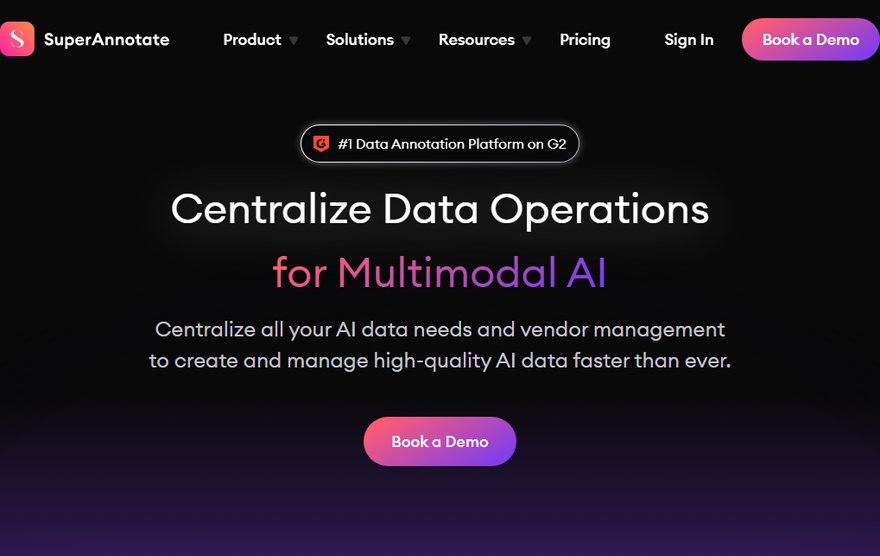Overview
Superannotate is a powerful platform that streamlines AI data management and annotation, catering to researchers and analysts working with NLP, computer vision, and generative AI. By centralizing data workflows, it enables teams to create, manage, and refine high-quality datasets with unparalleled efficiency. Whether annotating text, images, or multimodal data, the platform offers customizable tools like the Builder for tailored annotation interfaces and advanced orchestration for CI/CD pipelines, ensuring seamless integration into existing research processes.
Designed for teams seeking precision and scalability, Superannotate stands out with its robust dataset versioning, vendor management, and access to a Marketplace of vetted annotation professionals. Its support for diverse data types makes it ideal for complex research projects requiring meticulous analysis. By combining intuitive tools with enterprise-grade features, Superannotate accelerates AI development, allowing researchers to focus on insights rather than data logistics.
Key Features
- Create custom annotation UI with Builder
- Build CI/CD pipelines with advanced orchestration
- Manage and version datasets efficiently
- Hire vetted annotation teams via Marketplace
- Support for multimodal data annotation
- Specialized solutions for RAG and RLHF
- Project progress monitoring and tracking
- Integration with partners and platforms
- Comprehensive documentation and learning resources
Use Cases
Medical Image Annotation for Research
Superannotate enables researchers to accurately label and annotate medical images such as X-rays, MRIs, and CT scans. The tool’s advanced AI-assisted features streamline the annotation process, ensuring high precision for tasks like tumor detection, organ segmentation, and disease classification. Researchers can collaborate in real-time, maintain data consistency, and export labeled datasets for training machine learning models to improve diagnostic accuracy.
Autonomous Vehicle Data Labeling
Superannotate supports the development of autonomous vehicles by providing robust tools for annotating LiDAR, radar, and camera data. Researchers can label objects like pedestrians, vehicles, and traffic signs with high accuracy, enabling the training of perception algorithms. The platform’s automation features reduce manual effort, while quality control mechanisms ensure reliable datasets for improving self-driving systems’ safety and performance.
Agricultural Drone Image Analysis
Superannotate aids agricultural researchers in analyzing drone-captured imagery to monitor crop health, detect pests, and assess soil conditions. The tool allows precise annotation of vegetation indices, disease patterns, and irrigation needs. By leveraging AI-assisted labeling, researchers can quickly process large datasets, derive actionable insights, and optimize farming practices for increased yield and sustainability.
Retail Shelf Analytics
Superannotate helps retail researchers analyze in-store shelf images to track product placement, stock levels, and promotional displays. The tool’s annotation capabilities enable labeling of products, packaging, and pricing information. Researchers can use the labeled data to train AI models for automating shelf audits, improving inventory management, and enhancing customer shopping experiences through better store layouts.
Wildlife Conservation Monitoring
Superannotate assists conservation researchers in analyzing camera trap and satellite imagery to monitor wildlife populations and habitats. The tool enables efficient annotation of species, behaviors, and environmental features. Researchers can leverage the labeled datasets to train AI models for tracking endangered species, detecting poaching activities, and studying ecosystem changes over time.
Target Audience & Industries
Target Audience
Superannotate is designed for businesses and individuals who require efficient and accurate data annotation for machine learning and AI projects. Businesses, including startups and enterprises, benefit from streamlined workflows, reduced manual labor, and improved annotation quality, enabling faster model training. Individuals, such as data scientists and researchers, gain access to powerful tools that simplify complex annotation tasks, saving time and enhancing productivity. The tool’s scalability and precision make it ideal for anyone working with large datasets or demanding annotation requirements.
Target Industries
Superannotate is particularly valuable for industries like healthcare, autonomous vehicles, retail, agriculture, and manufacturing. In healthcare, it aids in medical image analysis for diagnostics. Autonomous vehicle companies use it for labeling sensor data to improve navigation systems. Retailers leverage it for product recognition and inventory management. Agriculture benefits from crop monitoring through annotated drone imagery, while manufacturers use it for quality control and defect detection. These industries rely on high-quality annotated data to drive AI innovation and operational efficiency.
Evaluation and Review
Advantages
- Customizable Annotation UI: Tailor the annotation interface to specific project needs with the Builder tool, enhancing efficiency and accuracy.
- Scalable Data Management: Efficiently manage and version datasets, ensuring seamless collaboration and reproducibility.
- Expert Annotation Teams: Access vetted professionals via Marketplace to ensure high-quality annotations for complex projects.
- Multimodal Support: Annotate diverse data types (text, images, etc.) in one platform, streamlining workflows for AI development.
- Advanced AI Integration: Leverage specialized solutions for RAG and RLHF to enhance model performance and fine-tuning.
- Comprehensive Monitoring: Track project progress and integrate with partner platforms for end-to-end pipeline visibility.
Limitations
- Learning Curve The platform’s extensive features and customization options may require time to master, especially for users new to annotation tools.
- Cost Considerations Advanced features or large-scale annotation projects may involve higher costs, particularly when leveraging vetted teams or specialized solutions.
- Integration Complexity While integrations with partners and platforms are supported, setting them up may require technical expertise or additional configuration.
- Performance Variability AI-driven features like generative AI or RAG may produce inconsistent results depending on data quality or model training.
Other Information
Domain Info
Created at: 2018-03-19
Expires at: 2030-03-19
Interest over time
Worldwide. Past 90 days. Web Search.

